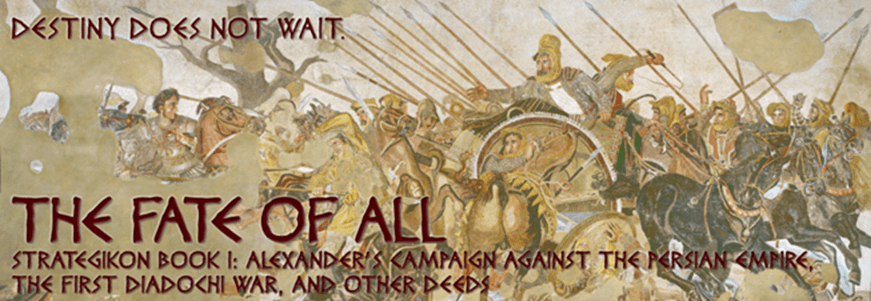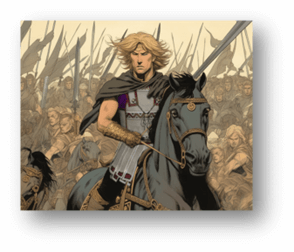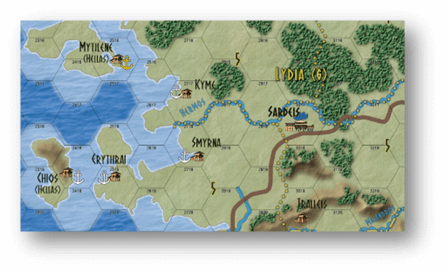
Developer’s Notes Part 2, by Anthony Morphet

Background
It was in early 2020, when out of the blue Fabrizio said to me that we were going to do a game of Alexander’s conquest of the Persians and his march to Babylon. After some spluttering I said: “When? Next?”. A laconic reply of “Sometime” he said and that was that.
So back to work we went, time went by. Deadly Northern Lights came out, and we discussed ancient histories and sources. After Sacred Oil, he sent me somewhat different maps of Turkey and Iraq. Then Die Festung Hamburg was released; people were being complimentary, nothing new from Fab, life was good.
So I was just setting myself up for another jaunt in the time machine back to my misspent youth in 1985 when suddenly he rings me and tells me to reset the dials 2,300 years or so earlier.
O Megas Alexandros was calling!
The Campaign
By a bizarre quirk of fate I have also nursed a lifelong interest in the Great Alexander. What had always fascinated me about his conquests, were not so much the battles but the campaign.
How on earth did he march all those men and animals from Greece to the Hindu Kush, whilst conquering the greatest empire the world had seen to date? That was his true greatness. Therefore getting the operational factors of the campaign right was my primary aim.
March Rates – Reality
Although we both read voraciously one of our start points was a series of long conversations with me describing the function and the details of junior staff calculations that were still valid up until 1945. Indeed rates of march have only significantly changed in the last 80 years with the complete mechanisation of armies, the widest adoption of macadamised roads for those vehicles to travel upon and the introduction of aircraft, particularly helicopters.
I stressed that even a deployment in a single column on a single route needs to be broken up into smaller bite size chunks. The main reason for this is to avoid the start/stop yo-yoing that annoys so many of us on daily commutes.
More importantly, developing a deep understanding of the concept of pass time is really key: A column whose head arrives on the battlefield at 10am will not be available to fight until the rest of it arrives. Why are long columns so slow? Men in columns don’t walk slower they just have to do a lot of waiting for the rear to catch up, or if you prefer for the rear to start the day’s march. Fabrizio summarises it well in the previous chapter.
So What?
Knowing how far had to be marched from Pella to Babylon and knowing how fast the army could be marched and knowing how long the original Alexander took, allowed the major parameters to be set: map size, hex size and turn length.
This in turn defined seasonality and its effects, naval speeds and had considerable input into the supply generation, storage and distribution rules. Armed with the foregoing Fab designed the algorithms and detailed rules which we then hacked at until balanced rules and charts appeared.
With that we had ensured the player was a general who plans a campaign. The key task of which is ordering your armies’ march columns. Your next task is ensuring they stay supplied.
Supply
 In his notes Fabrizio waxes lyrical about the supply rules and rightly so. It is the key to campaigning.
In his notes Fabrizio waxes lyrical about the supply rules and rightly so. It is the key to campaigning.
Nevertheless, we were very keen to streamline this so that the game’s algorithms and tables did the work. The player has to plan but not to keep masses of notes or have a counter for each bushel of grain. We did the research; counting forage and analysing provinces, allocating each one a capacity to support forces. In the end the supply points system used in 1985 provided the basis for a system which was counting oats and hay rather than POL and missiles.
There were two areas where extra effort was required by us and development was a relatively long period of gestation.
Seasonality
Getting the seasons right across such a large map with such diverse regions and climates was a distinct challenge but it had to be done, as seasonality has two main effects:
The first is the effect of weather upon movement and that is where the defined winter area was born.
The second is the effect of the various seasons upon the provinces’ ability to support foraging armies. It is here, that after much discussion and trial we moved past a simple “winter is bad” rule and added the nuances of annual crop cycles and animal husbandry to the foraging tables.
The results should inform a General’s plan for movement on a month by month basis, helping to define the requirements to establish shipping routes, supply depots or even designate lands for pillage and plunder at differing times of the year.
Naval Supply
Once again what was not wanted was a plethora of ships sailing around with two bales of hay in each.
We tried several systems, but in the end we modified the convoy rules developed for DNL to establish the shipping routes. Noting that you require safe ports and you use your own fleets as merchants, it behoves the Alexandrians to secure the sea lanes before they convert their fleets to transports.
Light Cavalry
The functions of light cavalry were discussed at length and it took a number of weeks and considerable testing to get the interactions between; patrolling cavalry, screening cavalry, reconnoitring cavalry and foraging cavalry in balance without having huge numbers of counters and skirmish after skirmish on the operational map.
Compressing all of those interactions for each army into two single die rolls on a pair of tables was a master stroke that made the campaign playable whilst still giving a good representation of contemporary campaign stratagems. How you divide up your Light Horse into each category is naturally still yours to decide.
Forced Marches
The last piece of the campaigning jigsaw was forced marching and I must give Fabrizio real credit for his rules design. Identifying from the historical sources the use by Alexander of forced marches for rapidly crossing terrain that couldn’t supply his army, and designing rules that rewarded that tactic was very astute.
What needed developing? Ensuring that even the best troops and the cavalry and not just the dross took some hits from lack of supply. After all it is difficult to move let alone to fight in all that kit if all your servants and slaves are dead.
The Tactical Game
I believe this distillation of ancient warfare into a set of rules which revolve around the ability of leaders to maintain control long enough to get the best troops into action at the point of decision most accurately reflects the descriptions of the battles that have come down to us.
Using good leaders to exploit powerful troops is the Alexandrian key to success. On the other side, maintaining control long enough to weather the initial storm and then grinding down the individual Macedonian components is probably the way forward.
Where to from Here
It all depends. If Alexander gets to Babylon there is still a world beyond. Not to mention Hannibal, Sulla and Caesar all waiting some centuries ahead.
One thought on “Exclusive: Fate of All Designer notes part 2”
Comments are closed.